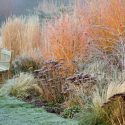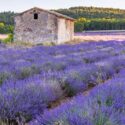It’s called winter honeysuckle or sweet breath of spring, and it’s thought to be invasive in many parts of the United States. Originally from China, this plant was introduced to the U. S. in the mid-1800s as an ornamental plant due to its fragrant, early spring flowers.
Despite its pleasing characteristics, Lonicera fragrantissima can cause significant environmental damage. It spreads rapidly and forms dense thickets that can displace native plants and disrupt ecosystems. The shrub is hard to control because it grows quickly from the ground up and makes a lot of berries that birds spread, making it easier for the plant to spread.
Control of Lonicera fragrantissima often involves a combination of mechanical removal (cutting, mowing, pulling) and chemical treatment.
According to the U. S Forest Service, Invasive species have contributed to the decline of 42% of U. S. endangered and threatened species and 18% of U. S. endangered or threatened species. Invasive species compete directly with native species for moisture, sunlight, nutrients, and space. They move and change native plant communities, hurt wildlife habitat and water quality, and could cause more soil erosion.
The federal government says that about 24% of the 20,000 plant species that are native to North America are in danger of going extinct. This is mostly because their habitats are being destroyed. You can help reverse this trend by planting great native plants in your garden.
A plant is considered native if it occurs naturally in a particular region or ecosystem without human introduction. There are many benefits to growing native plants. First, these plants have adapted better to the soil, water, and weather than plants that came from other parts of the world. They need fewer fertilizers and pesticides or use less water. Second, they are unlikely to escape and become invasive, destroying natural habitats. Third, they support wildlife, providing shelter and food for native birds and insects, while exotic plants do not.
With their fragrant flowers and twining growth habits, honeysuckles are a popular garden plant. However, some invasive varieties like Japanese honeysuckle and Amur honeysuckle can quickly get out of control Identifying lookalike plants is key to avoiding unwanted invasives.
If you’re wondering “what plants look like honeysuckle?” you’ve come to the right place! Below we describe 8 common imposters frequently mistaken for honeysuckle.
Trumpet Honeysuckle
This native woody vine has similar tubular red flowers, but with flared, trumpet-shaped ends It twines up trellises and arbors, blooming spring to summer Trumpet honeysuckle attracts hummingbirds and other pollinators.
Trumpet Creeper
Another lookalike with “trumpet” in the name, this aggressive woody vine has clusters of bright orange trumpet-shaped blooms. It needs frequent pruning to keep it under control. Hummingbirds love the nectar-rich flowers.
Coral Honeysuckle
This honeysuckle species has overlapping pairs of elongated leaves along vining stems. Tubular flowers come in shades of coral, pink, yellow, or red depending on variety. A hummingbird favorite.
Wisteria
Wisteria has hanging clusters of very fragrant, pea-like flowers in spring. However, it becomes a fast-growing, heavy woody vine that can damage structures. Support is needed.
Japanese Hydrangea Vine
This climbing hydrangea relative has large leaves and flattened clusters of small white flowers. It grows 30-50 feet high by clinging aerial rootlets to surfaces.
Virginia Creeper
With five-pointed leaves and bluish berries, this fast-growing vine can blanket trees and buildings. Red fall color. Can be invasive. Often confused with poison ivy, but leaves have five distinct points, not three.
Crossvine
Crossvine is a flowering woody vine with thick, leathery leaves arranged in pairs along the stem. Clusters of tubular orange and yellow flowers are pollinator magnets.
Carolina Jessamine
Also known as yellow jessamine, this vine has yellow trumpet-shaped flowers that appear in early spring. The leaves are paired along the vine, similar to crossvine. Can become invasive.
Be sure to properly identify any plants that resemble honeysuckle before allowing them to establish. Some natives like trumpet honeysuckle are great additions, while aggressive growers like Japanese honeysuckle should be avoided. When in doubt, consult your local extension office.
Discover more beautiful native plants
| Hardiness | 4 – 8 |
|---|---|
| Heat Zones | 3 – 8 |
| Plant Type | Shrubs |
| Genus | Lonicera |
| Exposure | Full Sun, Partial Sun |
| Season of Interest | Spring (Early) Winter |
| Native Plants | United States |

A Glowing Winter Garden with Dogwood, Sedum and Grasses

Plant This Honeysuckle, Not That Honeysuckle!
FAQ
What plant is similar to honeysuckle?
What is the purple plant that looks like a honeysuckle?
What is the pink flower that looks like a honeysuckle?
What does the invasive honeysuckle look like?
Which honeysuckle vines grow best?
Trumpet honeysuckle ( L. sempervirens) and Japanese honeysuckle ( L. japonica) are two of the most ornamental of the honeysuckle vines. Both grow in USDA plant hardiness zones 4 through 9, but trumpet honeysuckle grows best in the Southeast, while Japanese honeysuckle thrives in the Midwest.
Is honeysuckle a shrub or a tree?
Honeysuckle belongs to the Caprifoliaceae family, including plants like Abelia and Snowberry. The Lonicera genus encompasses both deciduous and evergreen species, which can be shrubs or twining vines. These plants are best known for their tubular flowers and sometimes for their berries.
What does a honeysuckle look like?
Learn how to plant, grow, and care for honeysuckle. Honeysuckles belong to the genus Lonicera and are native to North America, Europe, and Asia, with about 180 identified species. They are characterized by long, trumpet-shaped flowers in bright red, yellow, and orange colors, most with yellow centers.
What is a yellow honeysuckle plant?
Lonicera flava (Yellow Honeysuckle): Native to the United States, this variety produces yellow flowers and is a good choice for native plant gardens. Lonicera albiflora (White Honeysuckle): This is a native North American vine mainly found in the southern United States.
- The Ultimate Guide to Growing Strawberries in Raised Beds - August 8, 2025
- No-Dig Garden Beds: The Easiest Way to Grow a Beautiful Garden - August 6, 2025
- How to Protect and Preserve Wood for Raised Garden Beds - August 6, 2025

